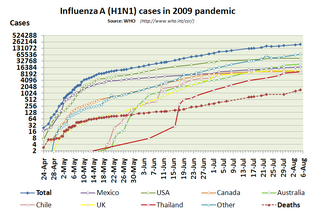
Swine influenza is an infection caused by any of several types of swine influenza viruses. Swine influenza virus (SIV) or swine-origin influenza virus (S-OIV) refers to any strain of the influenza family of viruses that is endemic in pigs. As of 2009, identified SIV strains include influenza C and the subtypes of influenza A known as H1N1, H1N2, H2N1, H3N1, H3N2, and H2N3.

In virology, influenza A virus subtype H1N1 (A/H1N1) is a subtype of influenza A virus. Major outbreaks of H1N1 strains in humans include the 1918 Spanish flu pandemic, the 1977 Russian flu pandemic and the 2009 swine flu pandemic. It is an orthomyxovirus that contains the glycoproteins hemagglutinin and neuraminidase. For this reason, they are described as H1N1, H1N2 etc., depending on the type of H or N antigens they express with metabolic synergy. Hemagglutinin causes red blood cells to clump together and binds the virus to the infected cell. Neuraminidase is a type of glycoside hydrolase enzyme which helps to move the virus particles through the infected cell and assist in budding from the host cells.

An influenza pandemic is an epidemic of an influenza virus that spreads across a large region and infects a large proportion of the population. There have been six major influenza epidemics in the last 140 years, with the 1918 flu pandemic being the most severe; this is estimated to have been responsible for the deaths of 50–100 million people. The most recent, the 2009 swine flu pandemic, resulted in under 300,000 deaths and is considered relatively mild. These pandemics occur irregularly.

The pandemic severity index (PSI) was a proposed classification scale for reporting the severity of influenza pandemics in the United States. The PSI was accompanied by a set of guidelines intended to help communicate appropriate actions for communities to follow in potential pandemic situations. Released by the United States Department of Health and Human Services (HHS) on February 1, 2007, the PSI was designed to resemble the Saffir-Simpson Hurricane Scale classification scheme. The index was replaced by the Pandemic Severity Assessment Framework in 2014, which uses quadrants based on transmissibility and clinical severity rather than a linear scale.
The Global Public Health Intelligence Network (GPHIN) is an electronic public health early warning system developed by Canada's Public Health Agency, and is part of the World Health Organization's (WHO) Global Outbreak Alert and Response Network (GOARN). This system monitors internet media, such as news wires and websites, in nine languages in order to help detect and report potential disease or other health threats around the world. The system has been credited with detecting early signs of the 2009 swine flu pandemic in Mexico, Zika in West Africa, H5N1 in Iran, MERS and Ebola.
The International Health Regulations (IHR), first adopted by the World Health Assembly in 1969 and last revised in 2005, are a legally binding rules that only apply to the WHO that is an instrument that aims for international collaboration "to prevent, protect against, control, and provide a public health response to the international spread of disease in ways that are commensurate with and restricted to public health risks and that avoid unnecessary interference with international traffic and trade". The IHR is the only international legal treaty with the responsibility of empowering the World Health Organization (WHO) to act as the main global surveillance system.

The 2009 flu pandemic in Hong Kong was part of the worldwide pandemic that started with the city's first reported case of influenza A virus subtype H1N1 infection, commonly called swine flu, on 1 May 2009, in a Mexican national who had travelled to Hong Kong via Shanghai. It was also the first reported case of in Asia. As of 25 November 2009, there have been 32,301 confirmed cases of swine flu in the city.

The 2009 swine flu pandemic, caused by the H1N1/swine flu/ influenza virus and declared by the World Health Organization (WHO) from June 2009 to August 2010, is the third recent flu pandemic involving the H1N1 virus. The first two cases were discovered independently in the United States in April 2009. The virus appeared to be a new strain of H1N1 that resulted from a previous triple reassortment of bird, swine, and human flu viruses which further combined with a Eurasian pig flu virus, leading to the term "swine flu".
The 2009 flu pandemic in the United States was caused by a novel strain of the Influenza A/H1N1 virus, commonly referred to as "swine flu," that was first detected on 15 April 2009. While the 2009 H1N1 virus strain was commonly referred to as "swine flu," there is no evidence that it is endemic to pigs or of transmission from pigs to people; instead, the virus spreads from person to person. On April 25, the World Health Organization declared a public health emergency, followed concurringly by the Obama administration on April 26.

In 1976, an outbreak of the swine flu, influenza A virus subtype H1N1 at Fort Dix, New Jersey caused one death, hospitalized 13, and led to a mass immunization program. After the program began, the vaccine was associated with an increase in reports of Guillain–Barré syndrome (GBS), which can cause paralysis, respiratory arrest, and death. The immunization program was ended after approximately 25% of the population of the United States had been administered the vaccine.

This article deals with the status and efforts regarding the 2009 swine flu pandemic by country and continent/region.

The 2009 flu pandemic in Asia, part of an epidemic in 2009 of a new strain of influenza A virus subtype H1N1 causing what has been commonly called swine flu, afflicted at least 394,133 people in Asia with 2,137 confirmed deaths: there were 1,035 deaths confirmed in India, 737 deaths in China, 415 deaths in Turkey, 192 deaths in Thailand, and 170 deaths in South Korea. Among the Asian countries, South Korea had the most confirmed cases, followed by China, Hong Kong, and Thailand.

A public health emergency of international concern (PHEIC) is a formal declaration by the World Health Organization (WHO) of "an extraordinary event which is determined to constitute a public health risk to other States through the international spread of disease and to potentially require a coordinated international response", formulated when a situation arises that is "serious, sudden, unusual, or unexpected", which "carries implications for public health beyond the affected state's national border" and "may require immediate international action". Under the 2005 International Health Regulations (IHR), states have a legal duty to respond promptly to a PHEIC. The declaration is publicized by an IHR Emergency Committee (EC) of international experts, which was developed following the 2002–2004 SARS outbreak.
Singapore has taken a series of measures against Middle East respiratory syndrome (MERS) and the potential threat of a pandemic.

The COVID-19 pandemic in Singapore is part of the worldwide pandemic of coronavirus disease 2019 caused by severe acute respiratory syndrome coronavirus 2. The first case in Singapore was confirmed on 23 January 2020. Early cases were primarily imported until local transmission began to develop in February and March. In late March and April, COVID-19 clusters were detected at multiple migrant worker dormitories, which soon contributed to an overwhelming proportion of new cases in the country.
Crisis Preparedness and Response Centre is the agency established by the Government of Malaysia under the 9th Malaysian Plan (2005–2010) as part of the overall strategy for effective disaster preparedness, outbreaks, crises and emergencies related to health The opening of the CPRC was conducted by Malaysian Health Minister Datuk Seri Chua Soi Lek on May 7, 2007. The CPRC is located at Level 6, Block E10, Complex E, Federal Government Administrative Center, Putrajaya.
Planning and preparing for pandemics has happened in countries and international organizations. The World Health Organization writes recommendations and guidelines, though there is no sustained mechanism to review countries' preparedness for epidemics and their rapid response abilities. National action depends on national governments. In 2005–2006, before the 2009 swine flu pandemic and during the decade following it, the governments in the United States, France, UK, and others managed strategic health equipment stocks, but they often reduced stocks after the 2009 pandemic in order to reduce costs.
The following is a timeline of the COVID-19 pandemic in Singapore in 2020.

The 2020–21 Singapore circuit breaker measures were a stay-at-home order and cordon sanitaire implemented as a preventive measure by the Government of Singapore in response to the COVID-19 pandemic in the country on 7 April 2020.
The following lists events that happened during 2023 in the Republic of Singapore.








